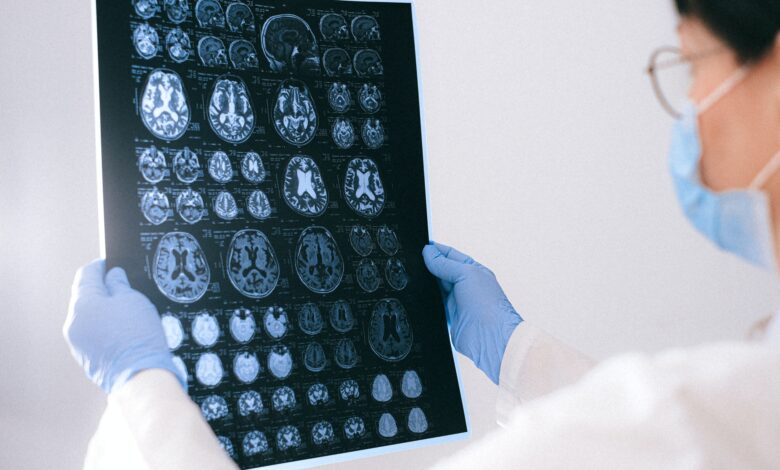
A brain tumor (brain cancer) is a mass of abnormal cells that grows in the brain out of control.
To find out all about this disease, see our dedicated sheet below.
Brain tumour, what is it?
A brain tumor is a mass of abnormal cells that grows in the brain out of control.
There are 2 main types of brain tumors depending on whether they are cancerous or not.
Benign (non-cancerous) tumors
They form quite slowly and most often remain isolated from neighboring brain tissue. They do not spread to other parts of the brain or other organs and are usually easier to remove with surgery than malignant tumors. However, some tumors, however benign, remain inextricable due to their location.
Malignant (cancerous) tumors
It is not always easy to distinguish them from neighboring tissues. Because of this, it is sometimes difficult to extract them entirely without damaging the surrounding brain tissue.
Examinations, such as magnetic resonance imaging (MRI), PET scan (positron emission tomoscintigraphy) and computed tomography (“CT scan”), make it possible to locate the tumor precisely. A biopsy (removal of tumor tissue in order to analyze it) is essential to determine the benign (non-cancerous) or malignant (cancerous) nature of the tumour.
Brain tumors are also distinguished according to their origin and location.
Primary brain tumors
Primary brain tumors are those that start in the brain. They can be benign (non-cancerous) or malignant (cancerous). Their name comes from the brain tissue in which they develop.
Among the most common malignant tumors are:
Glial tumors, or gliomas (malignant tumors)
They represent 50 to 60% of all brain tumors. They are formed from glial cells, cells acting as a support structure for nerve cells (neurons).
Medulloblastomas (malignant tumors)
They develop from the spinal cord at the embryonic stage. They are the most common brain tumors in children.
Among benign primary tumors
Rarer than primary malignant tumors are hemangioblastomas, meningiomas, pituitary adenomas, osteomas, pinealomas, etc.
Secondary tumors
Secondary or metastatic tumors are malignant (cancerous) and originate from other organs where cancer exists and whose tumor cells have migrated to the brain and are multiplying there. Tumor cells are carried by the blood and most often grow at the junction between the white matter and the gray matter of the brain.
These secondary tumors are more common than primary tumors. Moreover, it is estimated that 25% of people who die of cancers of all kinds are carriers of brain metastases 1 . Among the tumors most frequently causing brain metastases: breast cancer, lung cancer, skin cancer (melanoma), kidney cancer, colon cancer, etc.
Who is affected by brain cancer?
Each year in France, around 6,000 people are diagnosed with a primary brain tumour. They represent 2% of all cancers2.
In Canada, primary brain tumors affect 8 out of 100,000 people. As for metastatic tumors, they affect about 32 people out of 100,000.
Large epidemiological studies show that the number of brain tumors in the West has been on the rise for several decades, without anyone really knowing why. However, the intensive use of the cell phone seems to be incriminated in the increase in the number of certain primary brain tumors as shown by numerous studies. In terms of cell phone use, children are more exposed to brain tumors than adults.
When to consult for a brain tumour?
Consult your doctor if you experience symptoms such as persistent and intense headaches, accompanied by nausea and blurred vision.
Symptoms of brain tumor (brain cancer) vary depending on the location of the tumor and its size.
Discover them all in this sheet.
Brain Tumor Symptoms
Symptoms vary depending on the location of the tumor and its size. As the tumor grows, whether benign or malignant, it exerts pressure on the neighboring cerebral formations, altering their functioning.
Please note that certain symptoms of a brain tumor can also be found in the event of a stroke, cerebral abscess, intracerebral hematoma or even in certain arteriovenous malformations, thus risking misleading the diagnosis.
Some of the most common brain tumor symptoms include:
- unusual, frequent and severe headaches;
- nausea and vomiting;
- vision problems: blurred vision, double vision or loss of peripheral vision;
- numbness or loss of feeling on one side of the body;
- paralysis or weakness of an arm or leg on one side of the body;
- dizziness, balance and coordination problems;
- speech problems;
- memory problems and confusion;
- changes in behavior or personality, changes in mood;
- hearing problems (especially in the case of acoustic neuroma, a tumor of the auditory nerve);
- epileptic seizures;
- loss of consciousness;
- a loss of appetite.
Discover in this detailed fact sheet the risk factors for brain tumours, as well as the various means of preventing its appearance.
Brain tumor risk factors
Although the causes of brain tumors are still poorly understood, certain factors seem to increase the risks.
Ethnicity
Brain tumors occur more often in individuals of Caucasian origin, except in the case of meningiomas (a generally benign tumor involves the meninges, in other words the membranes covering the brain), which are more frequent in individuals of African origin.
age
Although brain tumors can occur at any age, the risks increase as you get older. The majority of tumors are diagnosed in people over the age of 45. However, some types of tumors, such as medulloblastomas, occur almost exclusively in children.
Exposure to radiation therapy
Individuals who have been treated with ionizing radiation are at greater risk.
Exposure to chemicals
Although further research is still needed to confirm this hypothesis, some ongoing studies indicate that sustained exposure to certain chemicals, such as pesticides, for example, could increase the risk of brain tumors.
Family history
If the existence of a case of cancer in the close family constitutes a risk factor for brain tumor, the latter remains moderate.
How to prevent brain cancer?
Since the precise cause of primary brain tumors is not known, there are no measures to prevent their occurrence. On the other hand, it is possible to prevent the appearance of other primary cancers at the origin of cerebral metastases by reducing the consumption of red meat, weight loss, an adequate intake of fruits and vegetables, the practice of a regular physical activity (prevention of colon cancer), skin protection in the event of exposure to solar radiation (skin cancer), smoking cessation (lung cancer), etc.
Using earphones systematically when using mobile phones reduces the amount of waves directed towards the brain and is beneficial in preventing certain types of tumours.
Discover in this sheet the medical treatments and the possible complementary approaches to treat the brain tumour.
- bridge
- Allergies (overview)
- Achluophobia : all about the fear of the dark
- At what age can you do bodybuilding?
- Fatigue in the morning: causes and remedies
- Prostate Cancer
- Acute bronchitis
- Psychiatry
- Cosmetic surgery
- 10 highly contagious diseases in autumn-winter
How to treat brain tumour?
Medical treatments
Treatments vary depending on the type of tumor, its size and location. Malignant tumors are usually treated with combination therapies such as surgery, chemotherapy, and radiation therapy.
Relatively high in children, the survival rate is variable in adults and depends on the type of tumor, its size, its infiltration into the surrounding tissues and the general operability of each person 2 .
Before starting a treatment, after the tumor has been precisely located (MRI, scanner, Pet Scan, cerebral angiography, etc.), the doctor often performs a biopsy (removal of part of the tumor, with the aim of analysis) when the exact diagnosis of the type of tumor remains unclear despite additional examinations. This is used to determine the nature of the tumor and whether it is benign or malignant (cancerous or not). The biopsy is performed by drilling a small hole in the bone of the skull, and is performed under local or general anesthesia.
Surgery
If the tumor is accessible, the first option consists in extracting it from the brain (resection). This is the main therapeutic means in the treatment of brain tumours2. Excision surgery also confirms the results of the biopsy because many tumors are heterogeneous (unequal dispersion of tumor cells within the tumor itself).
In some cases, the tumor cells easily detach from the surrounding brain tissue and the tumor can be removed whole. In others, the tumor is near critical or very sensitive areas, making surgery more risky. If the tumor is located near the optic nerve, for example, surgery could compromise vision.
Whatever the case, the surgeon always does his best to remove as much of the tumor as possible without reaching the essential areas of the brain.
Radiosurgery
If the tumor is not accessible to traditional surgery, radiosurgery using a gamma ray bistoury (gamma knife) may be considered. More precise and powerful than radiotherapy, this technique uses powerful radiant beams, directed at one time and precisely and directly on the tumor, for a few minutes or hours. It does not require an opening of the skull or a burr hole.
Radiotherapy
Although the rays are less powerful than those used in radiosurgery, they nevertheless make it possible to cover larger regions of the brain. In some cases, radiation therapy is directed at the tumor only. In others, the whole brain is irradiated, for example after surgery, to destroy remaining tumor cells, or when several tumors have lodged in the brain (metastases) and cannot be removed by surgery. Finally, radiotherapy is used in the event of a tumor that is not entirely extracted.
Chemotherapy
Although brain tumors rarely metastasize outside the brain, chemotherapy is used to better control the disease. Some types of brain cancers respond to chemotherapy. Chemotherapy drugs can be given intravenously or orally. In some cases, they can be injected into the spinal cord to target the nervous system only.
Innovative approaches consist in introducing directly into the brain, after surgery, a small disk that diffuses chemotherapeutic agents into brain tissue for a few weeks.
Followed
It is sometimes difficult to eliminate all brain cancer cells. If some of them remain in the brain, the tumor may reappear. Regular follow-up and monitoring are therefore essential.
In addition, because of the possible neurological sequelae due to the tumor or its treatment because of the possible neurological sequelae due to the tumor or its treatment (control of movements or speech, etc.), a period of rehabilitation is often necessary . It requires the assistance of specialized practitioners with the help of specialized therapists (physiotherapist, occupational therapist, speech therapist, etc.).
Complementary Approaches to Brain Tumor Treatment
Consult our Cancer fact sheet to find out about all the complementary approaches that have been studied with people with cancer, such as acupuncture, visualization, massage therapy and yoga.
These approaches can be beneficial when used in addition to, but not as a substitute for, medical treatments.














